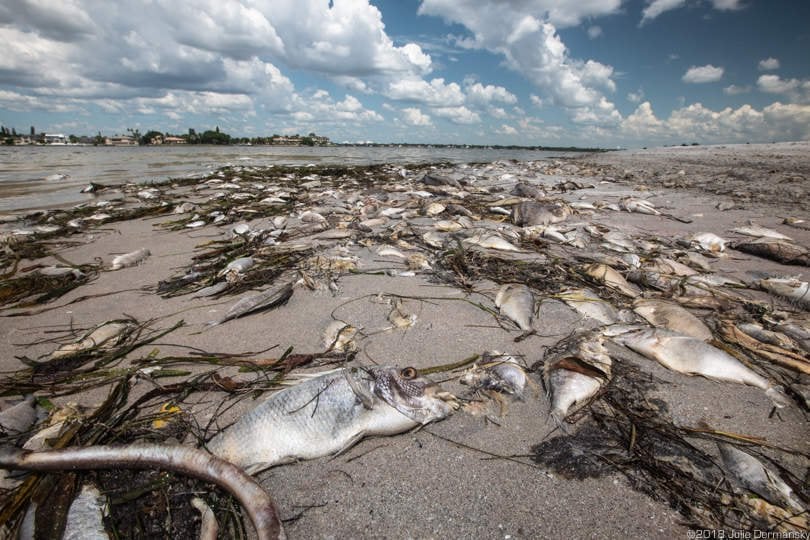
“Covering stuff up doesn’t make it go away,” said Lilly Womble, an 18-year-old on vacation on Florida’s Sanibel Island. The island is world renowned for its sea shells but that day we were watching employees from the Sanibel Moorings Resort pull a sheet over a dead loggerhead sea turtle on the beach behind the hotel. One of the men covering the turtle said that people had seen it long enough, and he didn’t want it to scare kids.
“I think it is better if kids see what we are doing to the planet,” Womble told me. “Maybe seeing the dead turtle will make them pay attention to the environment.” Her 9-year-old sister Ellie agreed, adding that “covering the turtle won’t stop other turtles from dying.”
Earlier that day the sisters had been on a charter fishing boat 10 miles off Sanibel Island’s coast, where they saw lots of dead fish, large and small, and another dead sea turtle floating on the Gulf of Mexico’s surface. Though they caught some fish, their father, an avid fisherman, had his daughters throw them back. He explained to them that it may be years before marine life can recover from the impacts of the ongoing explosion of toxic algae that already has killed hundreds of tons of fish and other sea life washing up on Florida’s southwest coast.
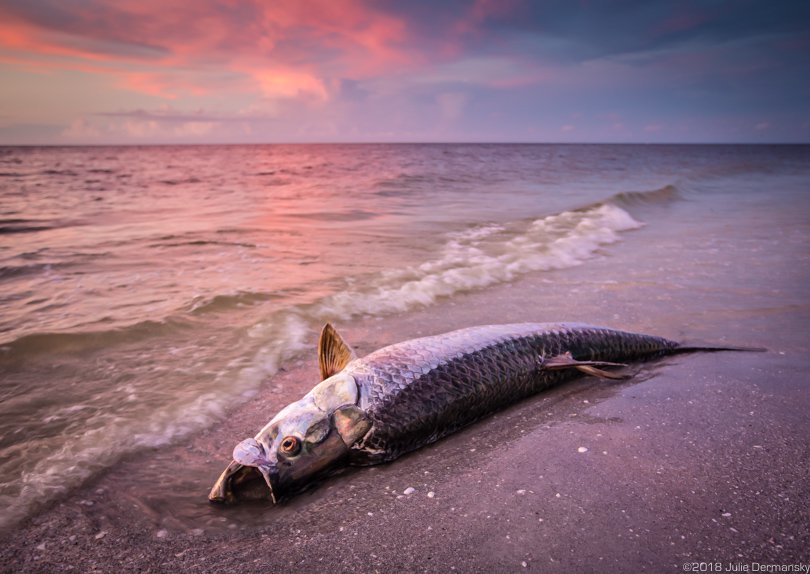
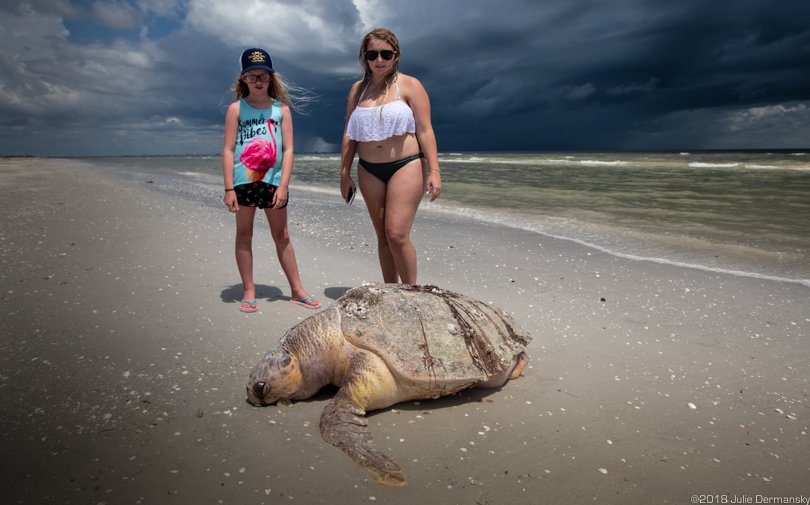
The mass mortality of aquatic life — which some have called “unprecedented” — along 150 miles of Florida’s Gulf Coast, stretching from Naples in the south to Sarasota in the north, is the result of harmful algal blooms, which have been supercharged by pollution.
A persistent red tide, caused by a toxin-producing marine alga, that began last October intensified this summer after a blue-green algae outbreak in Lake Okeechobee made its way to the Gulf. Conditions were exacerbated when the US Army Corps of Engineers released water from the lake to the sea in order to avoid flooding, killing the lake’s blue-green algae (more precisely known as cyanobacteria) and further feeding the red tide at sea. Both algae pose public health risks to people and exposure to their toxins can be fatal to aquatic life.
A State in Crisis
The Sanibel Moorings staff aren’t the only ones trying to cover up issues related to Florida’s dual toxic algae crisis, say critics of the response.
Florida Governor Rick Scott and many other politicians involved in protecting Florida’s water are trying to downplay the human role in the crisis, according to Jason Pim. Pim is a Cape Coral waterfront homeowner and had to temporarily evacuate his family due to the rancid odor from the toxic blue-green algae that had taken over the canal in his backyard.
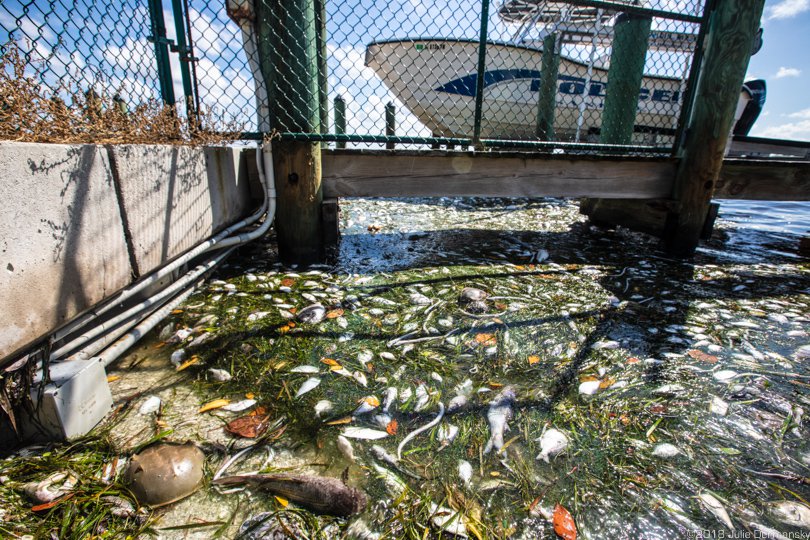
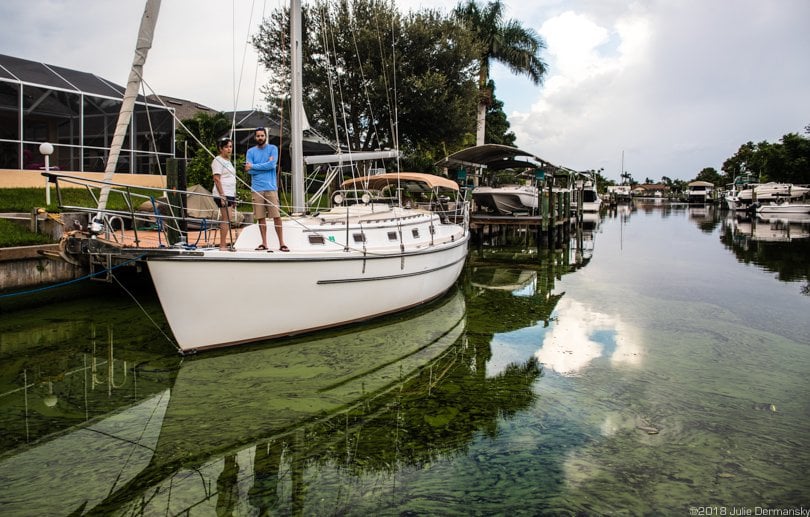
I met the Womble sisters and Pim during my second trip to Florida this summer. I returned two weeks after first documenting the environmental crisis in July ― spurred to return after watching national news reports show the mounting fish kill and fail to mention pollution’s contribution.
Governor Scott declared a state of emergency on August 13. The proclamation secured funding to help pay for the removal of the hundreds of tons of dead fish and other animals, including sea turtles and manatees, both endangered species, from Florida beaches in order to encourage tourism.
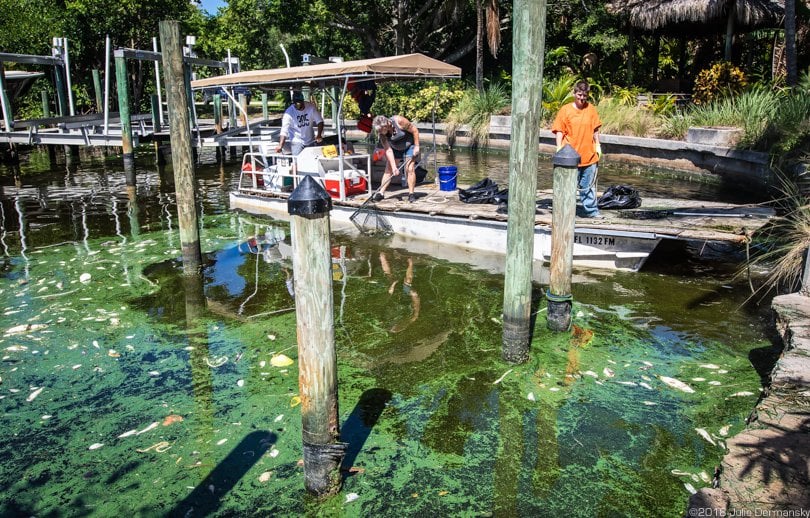
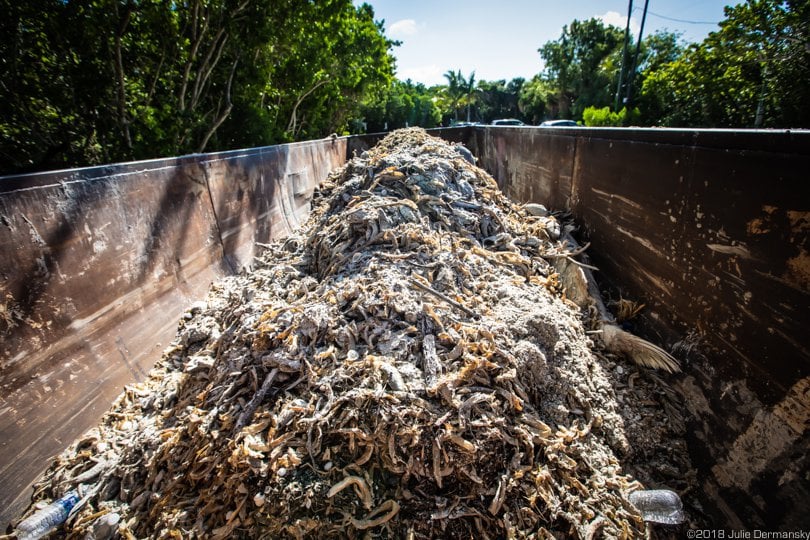
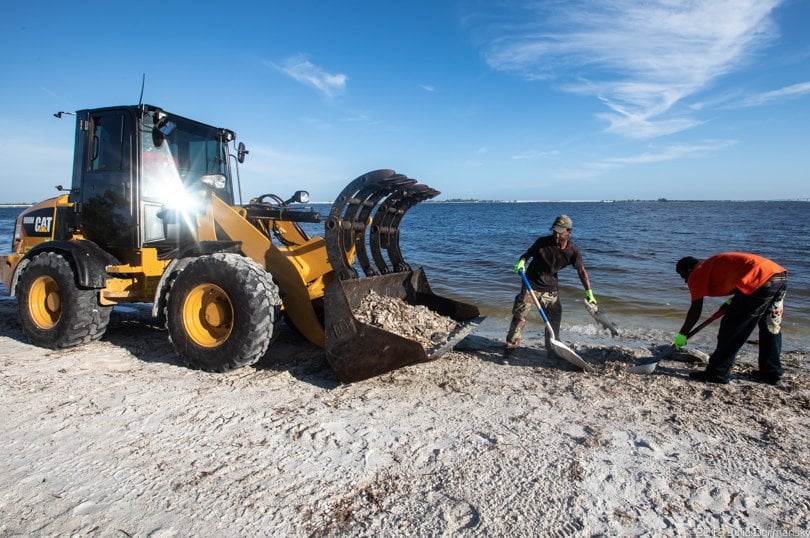
The governor’s declaration follows another one he made in July in response to the cyanobacteria crisis impacting inland waterways stretching from the Gulf Coast to the Atlantic. These freshwater rivers and canals are receiving toxic algae-laden water discharged from Lake Okeechobee under orders of the Army Corps.
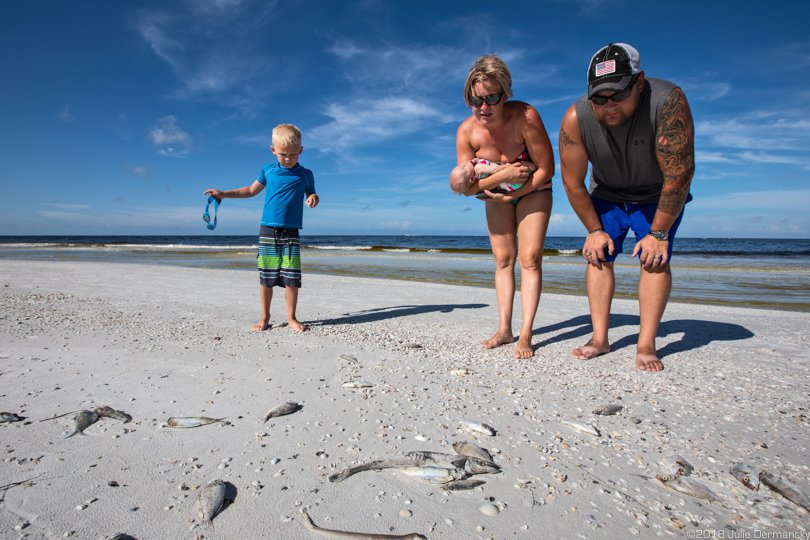
Too Much Nutrient Pollution in the Water
Many state politicians and officials are quick to point out that the algae creating both toxic situations are naturally occurring organisms. However, they fail to mention that the algae’s current population explosions and the aftermath are not solely natural phenomena.
Pollution from high levels of nitrogen and phosphorus are feeding two different harmful blooms: Red tide is caused by a marine plankton impacting the Gulf Coast, and the freshwater cyanobacteria (blue-green algae) is affecting inland waterways.
The two blooms are caused by distinct organisms but both are responding to excess nutrients running off the land into Florida’s fresh and saltwaters and feeding the toxic algae population booms.
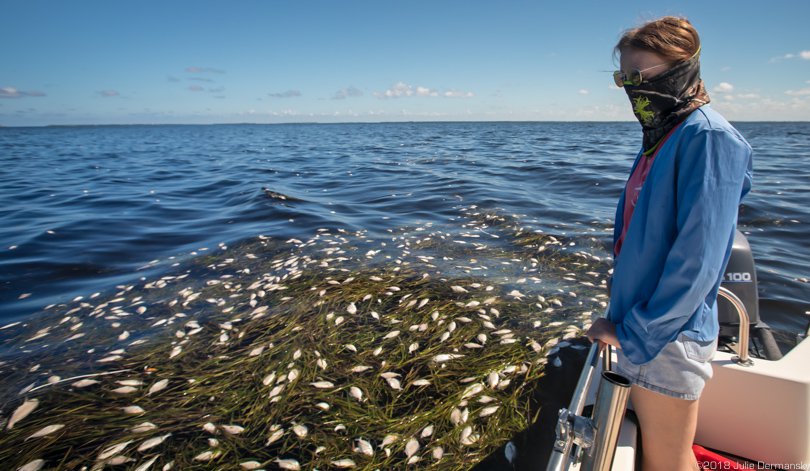
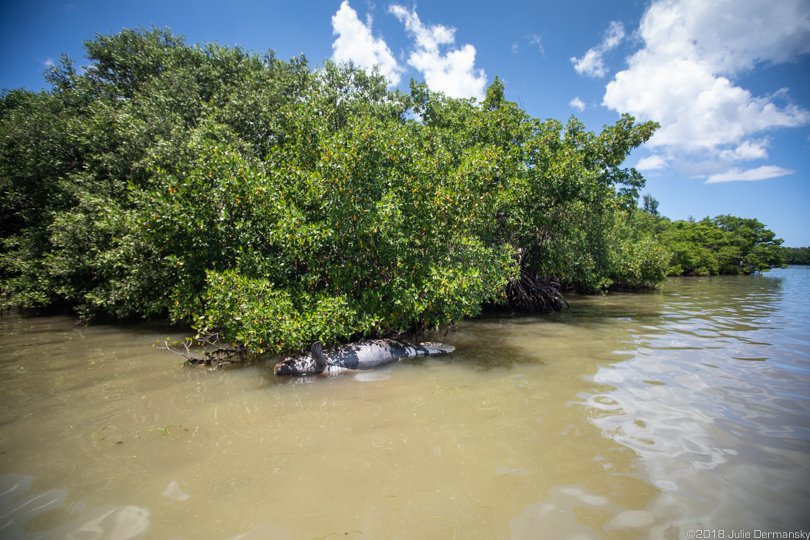
Florida’s water quality issues have been under Gov. Scott’s responsibility for the last eight years. Instead of doing anything to prevent the two current toxic algae crises, however, Scott has been “throwing gasoline on this marine life dumpster fire,” Pim said. “The Scott administration spent eight years deregulating and slashing budgets — supposedly benefitting us tax payers. But cleaning this mess up will cost us many times more than if our leaders would have had the political courage to limit the nutrient pollution in the first place.”
Like Pim, Dr. Rick Bartleson, a scientist with Sanibel-Captiva Conservation Foundation’s (SCCF) marine lab, believes regulating nutrient pollution is necessary to prevent future outbreaks.
The SCCF’s mission is to protect coastal habitats and aquatic resources on Sanibel and Captiva Islands and the surrounding watershed. It is collecting the sea turtles stranded on the islands, most of them dead, and monitoring how many are dying from the red tide.
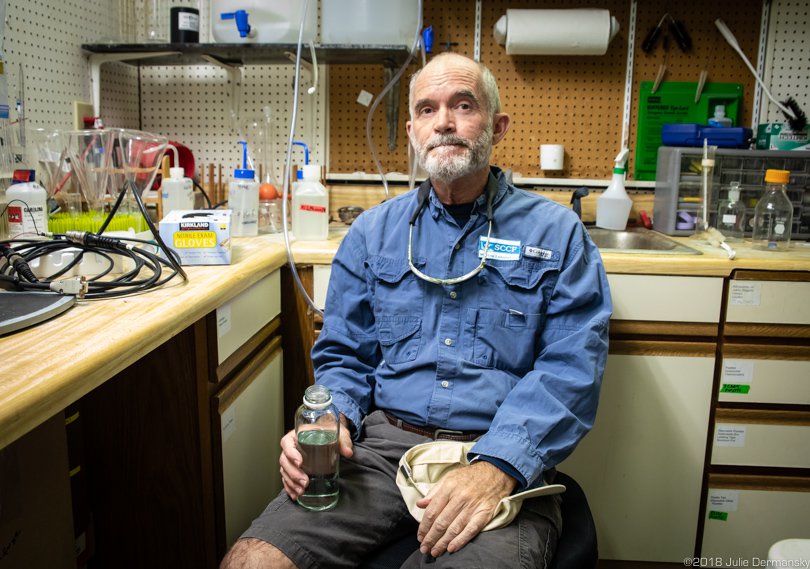
To address Florida’s water quality problems, the foundation is pushing to end development in wetlands (which act as natural water filters), establish protective water quality standards, and upgrade stormwater regulations for both urban and agricultural areas.
Bartleson is troubled that many reports about Florida’s toxic algae crisis quote politicians who stress that red tide is a natural occurrence and happens every year but omit the role eutrophication plays in increasing the intensity and duration of red tide blooms.
Eutrophication, or the over-enrichment of water by nutrients such as nitrogen and phosphorus, has emerged as one of the leading causes of water quality impairment — not just in Florida but in water bodies worldwide, Bartleson explained. Fertilizers used on lawns and crops and waste from septic systems leach excess nitrogen and phosphorus into waterways, feeding toxic algae blooms everywhere.
Bartleson believes future toxic algae outbreaks can be curbed, but that it will only happen if politicians turn to scientists for solutions.
Counting Turtles, Dead and Alive
I met Kelly Sloan, SCCF’s turtle specialist, while photographing the dead loggerhead sea turtle near the Sanibel Moorings Resort. Sloan removed the sheet and measured and marked the turtle in order to indicate it had been counted and sampled before she notified the island’s sanitation department that they could bury it. Running short on space, the foundation can no longer collect all of the dead turtles, and this dead loggerhead was too big to handle. Only a small sample of the turtle was collected to determine how it died.
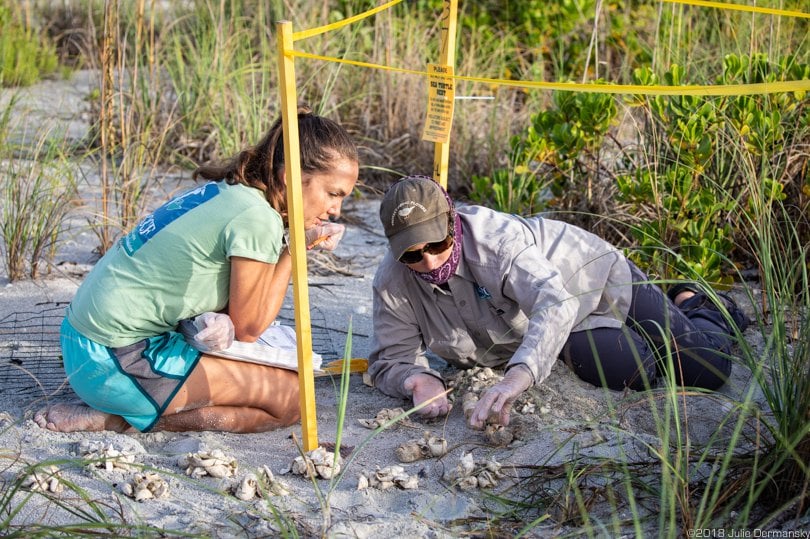
Sloan is also responsible for monitoring the sea turtle nests on Sanibel Island. I joined her and Audrey Albrecht, SCCF’s shorebird coordinator and biologist, as they continued an inventory of sea turtle hatchlings by counting recently hatched eggs in nests.
While digging up designated nests from the sand and counting the eggs, they found three alive — hatchlings likely too weak to make it out of the nest on their own.
One died shortly after it was found. Another was too weak to swim off on its own, and is now in rehabilitation. The third hatchling made it out into the Gulf with a little extra help from Sloan. She assured me that the baby sea turtle had a good chance to make it past the red tide because the hatchlings are born with a yolk sack that provides them energy for their first few days.
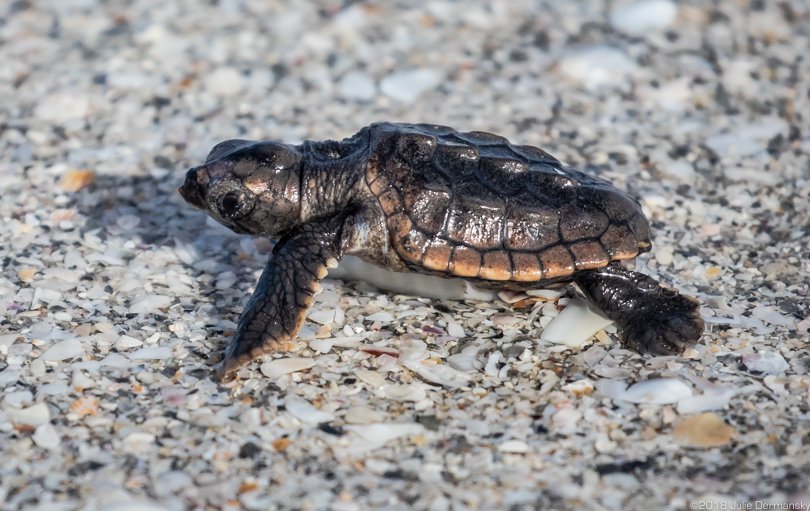
Sloan is hopeful that most of the sea turtle hatchlings along Florida’s southwest coast will be able to swim beyond the toxic algae unaffected, which reflects the scientific consensus at the moment.
After the tiny turtle swam off, we continued in silence down the beach littered with dead fish as the scientists monitored the other turtle nests, counting the future prospects of these endangered animals.
Our most important fundraising appeal of the year
December is the most critical time of year for Truthout, because our nonprofit news is funded almost entirely by individual donations from readers like you. So before you navigate away, we ask that you take just a second to support Truthout with a tax-deductible donation.
This year is a little different. We are up against a far-reaching, wide-scale attack on press freedom coming from the Trump administration. 2025 was a year of frightening censorship, news industry corporate consolidation, and worsening financial conditions for progressive nonprofits across the board.
We can only resist Trump’s agenda by cultivating a strong base of support. The right-wing mediasphere is funded comfortably by billionaire owners and venture capitalist philanthropists. At Truthout, we have you.
We’ve set an ambitious target for our year-end campaign — a goal of $250,000 to keep up our fight against authoritarianism in 2026. Please take a meaningful action in this fight: make a one-time or monthly donation to Truthout before December 31. If you have the means, please dig deep.